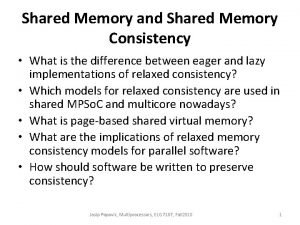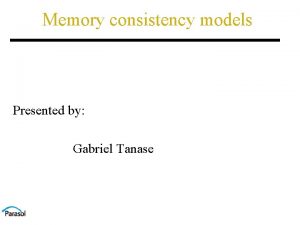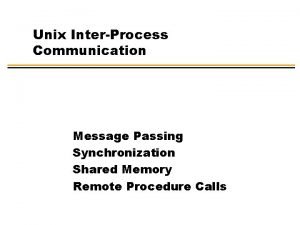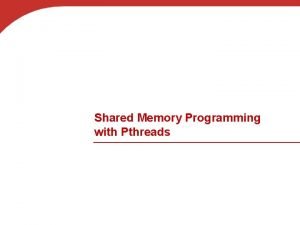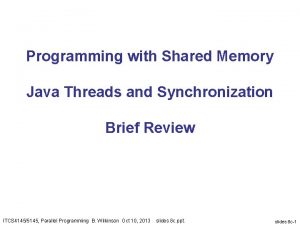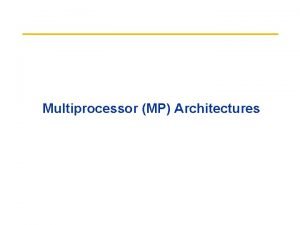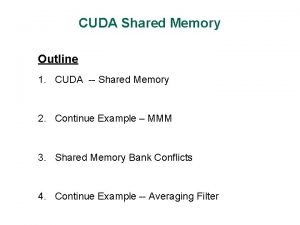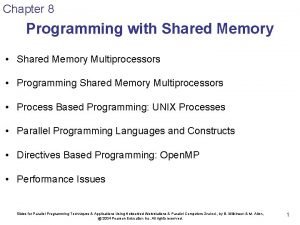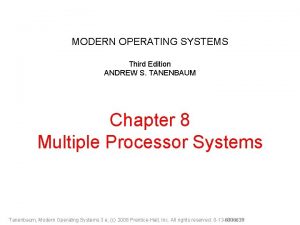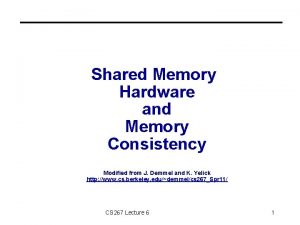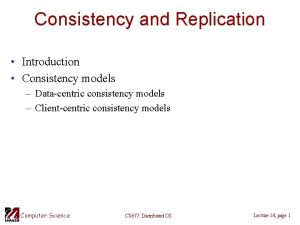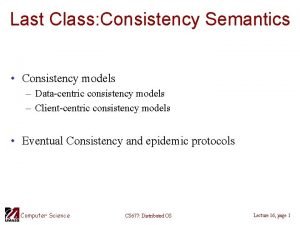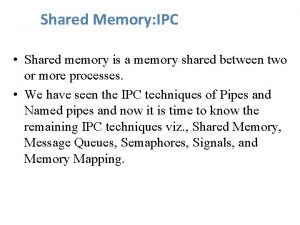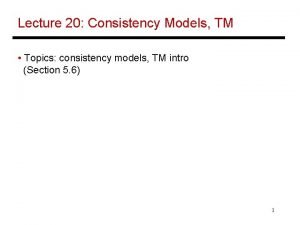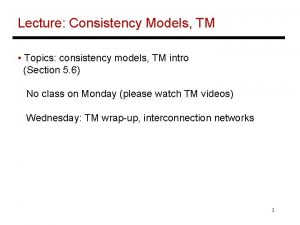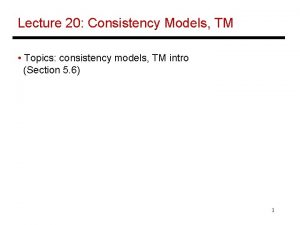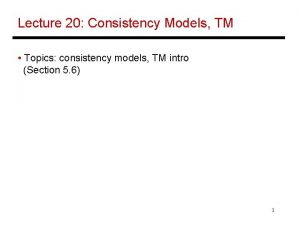Shared Memory Consistency Models SMP hardware organization SMP

























- Slides: 25

Shared Memory Consistency Models

SMP hardware organization

• SMP systems support shared memory abstraction: all processors see the whole memory and can perform memory operations on all memory locations. • Two key issues in such an architecture: – Cache coherence: how the data values should be propagated among caches/memory. • Sequentialize accesses to one memory location – Memory consistency model: formal specification of memory semantics • Define the semantic for accesses to ALL memory locations. • The timing (the early and late bounds) when a value in memory (cache + memory) can be propagated to any processor. • The model affects the applicability of many hardware and software optimization techniques.

A Coherent Memory in an SMP System: Intuition Initially flag 1=flag 2=0; P 1: flag 1 = 1 if (flag 2 == 0) critial section P 2: flag 2 = 1; if (flag 1 ==0) critical section Can we guarantee that one process is in the critical section? Needs to order the memory access among different memory locations – this is what memory consistence model does!!

A Coherent Memory in an SMP System: intuition • Reading the location should see – The latest value written by any process – Sequential consistency model • On uniprocessors – No issues between processes • Multiprocessors – Coherent as if the processes were interleaves on a uniprocessor.

Problems with the Intuition • Value returned by a read should be last value written – “Last” is not well defined: • Last write issued to the memory system? • Last in the program? • Last write in time? • Memory consistency model is concerned about the program behavior: so “last” should be in terms of program order. – In sequential program: order of operations in the machine language presented to the processor. – In multi-threaded programs (those for SMP machines), program order is only defined within a process. • Need to make sense of orders across processes.

Formal definition of coherence memory (sequential consistency) • Lamport’s definition: A multiprocessor system is sequentially consistent if the result of any execution is the same as if the operations of all the processors were executed in some sequential order, and the operations of each individual processor appear in this sequence in the order specified by its program.

Another formal definition of sequential consistency • Results of a program: values returned by its read operations • A memory system is coherent if the results of any execution of a program are such that for each location, it is possible to construct a hypothetical serial order of all operations to the location that is consistent with the results of the execution and in which: – Operations issued by any particular process occur in the order issued by that process, and – The value returned by a read is the value written by the last write to that location in the serial order. – All must see the same hypothetical serial order

Formal Definition of coherence memory • Two necessary features: – Write propagation: value written must become visible to all others (instantaneously). – Write serialization: write to location seen in the same order by all • If one sees W 1 after W 2, noone should see W 2 after W 1. • No need for analogous read serialization since read is not visible to others.

Sequential consistence example P 1: A=1 B=2 Read A, B P 2: A=2 B=1 Read A, B Is it possible for P 1 to have A=1, B=2 and P 2 to have A=2 B=1? Is it possible for P 1 to have A=1, B=1 and P 2 to have A=2, B=2?

Sequential consistent examples

Complication in hardware software support for sequential consistent

Complication in hardware software support for sequential consistent

Complication in hardware software support for sequential consistent

• Sequential consistency in architectures with caches – More chance to reorder operations that can violate sequential consistency. • E. g. write through cache has the similar behavior as write buffer. – Even if a read hits the cache, the processor cannot read the cached value until its previous operations by program order are complete!! – Issues: • Detecting when a write a complete needs more transactions. • Hard to make propagating to multiple copies atomic: more challenging to preserve the program order.

Sequential consistency requirement • Sequential consistency requirement: – Program order requirement: a processor must ensure that its previous memory operation is complete before proceedings with the next memory operation in program order. • A write is complete only after all invalidates (or updates) are acked. – Write atomicity requirement: the value of a write not returned by a read until all invalidates are acked.

Sequential consistency requirement Can we change the order of any of the following sequences? A=1 B=2 A=1 =B =A =B

• The program order requirement and write atomicity requirement in sequential consistency model make many hardware and compiler optimizations invalid. – Memory reference order must be strictly enforced. – Instruction scheduling, register allocation, etc

Relaxing program order • Sequential consistency model is too strict. – Coming from hardware point of view, trying to deal with the worst case scenario. • Program order, write atomicity. • From the software point of view: – What do we call a threaded program that can potentially read/write to the same memory location? • Mostly wrong/non-deterministic programs with race conditions. – Most of the correct threaded programs do not have race conditions. • No need to enforce the sequential consistency all the time.

Relaxing all program orders • Relaxing all program orders may not be a big deal. – Between synchronization points, multiple writes or one write/multiple reads to the same location race condition. – If no race condition, sequential consistence can be achieved by completing all memory operations at synchronization.

Weak ordering • Two types of memory operations: data and synchronization. – Synchronization operation can only be carried out when all memory operations before it are completed. • Hardware support: use a count to keep track of outstanding memory operations. – Weak ordering = sequential consistence for programs without race condition – Is the semantic defined for programs with race condition?

Relaxed memory models (in between) • Relax program order requirement – E. g. write and read different locations • Relax write atomicity requirement. • The differences are subtles – each enables some hardware/software optimizations and prohibit other types of optimizations.

Relax program order • Read/write order for the same address must always be enforced. • Read/write order for different addresses is less important. – Sometimes it can still be important. • Relax: – A write to a following read (of a different address). – A Write to a following write – A read to a following read or write.

Relax write atomicity • Allow a read to return the value of another processor’s write before the write is complete (visible to all processors) • Allow a read to return the value of its own value before the write is complete.

Some relaxed models
 Shared memory consistency models: a tutorial
Shared memory consistency models: a tutorial Intel processor
Intel processor Symmetric shared memory architecture
Symmetric shared memory architecture Replicated data consistency explained through baseball
Replicated data consistency explained through baseball Smp hardware
Smp hardware Linux
Linux Monotonic reads
Monotonic reads Client-centric consistency models
Client-centric consistency models Memory consistency
Memory consistency Posix shared memory synchronization
Posix shared memory synchronization Coffman condition
Coffman condition Shared memory in java
Shared memory in java Centralized shared memory architecture
Centralized shared memory architecture Interprocess communication shared memory
Interprocess communication shared memory Symmetric shared memory architecture
Symmetric shared memory architecture Shared memory bank conflicts
Shared memory bank conflicts Symmetric shared memory architecture
Symmetric shared memory architecture Distributed shared memory
Distributed shared memory Shared memory approaches in distributed system
Shared memory approaches in distributed system Murat olcay
Murat olcay Design issues of distributed shared memory
Design issues of distributed shared memory Acc shared memory
Acc shared memory Shared virtual memory
Shared virtual memory Example of mimd
Example of mimd Show the detailed abstract view of dsm
Show the detailed abstract view of dsm What is shared memory
What is shared memory

